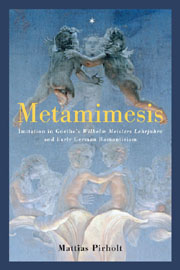Book contents
- Frontmatter
- Contents
- Acknowledgments
- List of Abbreviations
- Introduction
- 1 Romanticism, Mimesis, and the Novel
- 2 Double-Entry Imagery: Johann Wolfgang Goethe's Wilhelm Meisters Lehrjahre
- 3 Imitation and Indolence: Friedrich Schlegel's Lucinde
- 4 Imitation and Simulation: Novalis's Heinrich von Ofterdingen
- 5 Beyond Romantic Representation: Clemens Brentano's Godwi
- Conclusions: Mimesis and the Critical Politics of Romanticism
- Bibliography
- Index
Introduction
Published online by Cambridge University Press: 05 February 2013
- Frontmatter
- Contents
- Acknowledgments
- List of Abbreviations
- Introduction
- 1 Romanticism, Mimesis, and the Novel
- 2 Double-Entry Imagery: Johann Wolfgang Goethe's Wilhelm Meisters Lehrjahre
- 3 Imitation and Indolence: Friedrich Schlegel's Lucinde
- 4 Imitation and Simulation: Novalis's Heinrich von Ofterdingen
- 5 Beyond Romantic Representation: Clemens Brentano's Godwi
- Conclusions: Mimesis and the Critical Politics of Romanticism
- Bibliography
- Index
Summary
Auf der andern Seite kann aber auch die Nachahmung des Wirklichen an Vollkommenheit unendlich zunehmen: denn die Fülle jedes Einzelnen ist unerschöpflich, und kein Abbild kann jemals ganz in sein Urbild übergehen. (KA I, 289)
Über das neuere Princip der Nachahmung der Natur. / Realisirung des Scheins (S III, 244)
From the very beginning mimesis and its various translations — imitatio naturae, imitation of nature, Nachahmung der Natur — have proved themselves to be ideological concepts. Plato's famous rejection of imitation in the Republic — that imitation of objects removes us one step further away from the world of ideas — has not only aesthetic and philosophical implications but political ones as well. Imitation is more precisely a form of activity that diverts the attention of the citizen from his or her real duty. In Aristotle mimesis becomes an anthropological theory. Imitation, Aristotle argues, is a fundamental faculty of mankind and an instinct implanted in man from birth. Accordingly, it seems reasonable to assume that his definition of drama as an imitation of human action, rather than of human characters, could be taken as an aesthetic theory that focuses on human relations more than anything else.
In present-day interpretations the ideological nature of mimesis continues to be an important issue. Erich Auerbach's famous exposition in Mimesis (1946) construes the evolution of represented realities in literature as essentially one that reflects the history of social and political conditions.
- Type
- Chapter
- Information
- MetamimesisImitation in Goethe's 'Wilhelm Meisters Lehrjahre' and Early German Romanticism, pp. 1 - 9Publisher: Boydell & BrewerPrint publication year: 2012



